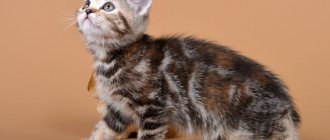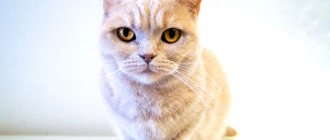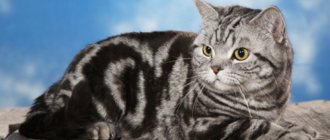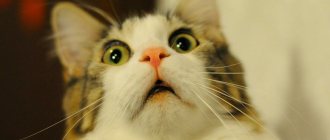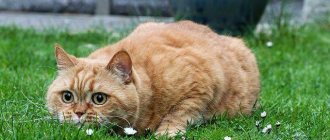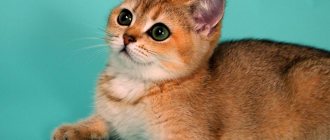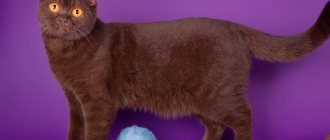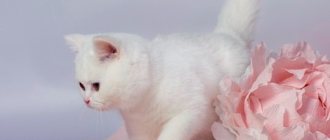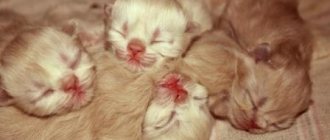Characteristics of the British chinchilla - character and behavior
Speaking about the characteristics of the breed, it’s worth saying right away that the British chinchilla is an aristocrat among cats. She quickly and easily gets used to her owner and his family, feeling like a full-fledged member of society. But at the same time, the cat avoids excessive displays of feelings, preferring to love everyone in silence. In addition, she does not like excessive attention - if you pet your pet too actively or hug him too much, the British chinchilla will get up and go to a quieter place. Because of this, they are perceived as cold and unfriendly animals.
Kittens quickly learn the rules of living in a family if they are clear and well formulated. They will never crap past the litter box, climb onto the bed, or steal food from the table, but to do this, the owner must immediately confront the pet with these facts and be adamant. You should not hope that after the cat has slept on the owner’s pillows several times and has not been punished for it, he will give up this pleasant habit.
It’s nice that even in a small apartment, a Briton will not cause unnecessary problems for the owners. They don’t rush around the rooms like crazy and don’t wake up the owner with howls if at three o’clock in the morning they suddenly want a snack and the cup is empty. Therefore, if you love cats, it will be difficult to find a better pet than the British chinchilla.
GOLDEN BRITISH CAT: COLOR STANDARD
The Golden British cat is the rarest of all British cat colors in the world.
Gold in color should be bright and necessarily rich, intense apricot color with a hint of real gold (it looks especially impressive in the sun) and without the slightest gray tint. Gray spots on gold are rejected.
The eye color of British Golden cats can be green and only green! Any other version of yellow eyes (copper, orange, golden, and other shade options) is a tough marriage. The standard does not currently accept gold colors other than green.
The coat of golden cats is, as a rule, slightly longer than that of solid colors and, most often, not as dense, although the presence of a dense double undercoat is mandatory. This remains a constant requirement for the British breed. It should be noted that no other color has such a simultaneously bright and soft coat color as gold. The more saturated the golden tone of the color is preserved, the better. The undercoat of a Golden Briton should only be apricot; if there is gray color there, the color is rejected.
Golden color cats are the most difficult to breed. As such, there are very few cats of this color, and from them it is still necessary to select those whose British breed qualities are the best. And at the same time, you also need to monitor the color of the undercoat, eye color and coat pattern, because... at the slightest mismatch of genes, everything goes bad. That is why the golden color of British cats is so expensive and so highly valued by experts.
Description of the breed - what does a British chinchilla cat look like?
When choosing a suitable pet, it is advisable to take into account not only the character, but also the external description. On the one hand, this allows you to make sure that this breed will be a good choice. On the other hand, it reduces the risk of acquiring a purebred cat with defects. Therefore, this point should be described in more detail.
Appearance
The head of the British chinchilla is wide, massive and at the same time almost round. The transition of the forehead to the muzzle is clear and pronounced when viewed from the side. The skull is strong and has smooth, rounded contours. The forehead should be convex - a flat one is considered a gross defect. The cheeks are also rounded and full, making the pet’s face look elegant and cute. Wide cheekbones further round the head visually.
The nose is wide, but short and straight. The length is most often average. Strong, well developed chin. The ears are set wide apart and are of medium size. They are wide at the base and gradually taper towards the tips to end in a graceful curve. Large, almost round eyes are set wide. Eye color depends on the main color – we’ll talk about this a little later. But it must be rich.
The body can be either large or medium. The muscles are well developed, the physique is strong. The back is straight. The chest is strong and deep, smoothly flowing into broad shoulders. Body of medium length, stocky. The tail is thick at the very base, but tapers neatly towards the tip. The length of the tail is 70% of the length of the body.
Size
The British Chinchilla has a height at the withers of about 35 cm. And a strong physique gives the cat solidity and confidence.
Weight
Thanks to their powerful build, British chinchillas weigh a lot. Typically, adult cats reach a weight of 5-8 kg, and among sterilized cats living in small apartments, and even eating well, it is not uncommon for an indicator of 10-12 kilograms. Cats are noticeably smaller than cats - they usually weigh only 3-4 kilograms. True, if your pet is sterilized, she will actively gain additional weight and can reach 6-7 kilograms.
Wool
The wool is plush and moderately soft. Not too long, but at the same time longer than short-haired breeds. Pleasant to the touch, with a delicate texture. Doesn't fit tightly to the body. The undercoat is abundant and pronounced. Both too coarse and too soft wool are not allowed - here connoisseurs of the British chinchilla have strict requirements. A long-haired chinchilla is also likely to be rejected at the show.
Colors
Chinchilla color comes in two varieties: tipped and shading. In the first option, the wool is partially colored - the base remains white, and the very tips, about 1/8 of the length, are colored the main color.
Shading or shaded is a little different. The wool is also partially dyed, but more intensely - the hair is dyed about a third of the length.
The breed standard allows for many color options. The main ones include:
- White wool,
- blue (and also blue gold),
- redhead,
- black,
- gray,
- gold (or, as an option, golden - according to the standard marking BRI NY 12),
- silver
But a marbled cat or a representative of the breed with a point color is definitely considered a defect - such colors are not found in purebred British chinchillas.
Silver chinchilla
Silver chinchillas are famous for their elegant snow-white fur. There should be no stains on the white fur coat - only true whiteness, everything else is rejected. The presence of yellow spots on the coat is evidence of mistakes that breeders make when mating, if one of the parents has silver and the other has gold in coat color.
Silver veiled
For this type of color, the main color of the coat and undercoat is white.
Photo ns 11 33 black silver shaded color point, Scottish Fold shorthair
Despite this, there are also inclusions of a different color (most often black), which have the appearance of a light coating. That is, only the very ends of the hair have a different color, which extends almost throughout the entire body and is slightly less noticeable on the sides. The fur on the chest and belly is almost always pure white. Any extraneous pattern on the animal's fur coat is not allowed. Such an amazing color creates the feeling of the presence of a veil on the back of the animal, as if the cat was covered with a light black translucent fabric. The cat's eyes have a neat black outline, as if someone skillfully applied makeup. The nose is also emphasized in black, the pads on the paws are dark, the fur around it must be white and not darkened. The characteristic eye color is green.
Representatives of silver shell color are marked during encoding with an additional letter s (silver) and the number 12 - indicating veiled.
British Shorthair black silver veiled BRI ns 12
There are varieties of veiled silver:
- cinnamon (BRI os 12);
- black (BRI ns 12);
- chocolate (BRI bs 12);
- lilac (BRI cs 12);
- faun (BRI ps 12);
- blue (BRI cs 12).
Silver shaded
Unlike just silver, shaded chinchilla has a more pronounced coating of dark color, since the hairs on the back are dyed deeper, by a third of the total length. The head, ears, back and tail of the British cat are distinguished by a more intense color. Then the dark tone smoothly passes to the chest and stomach, while acquiring a lighter shade, as if the artist added white paint to the palette and skillfully shaded it, creating a real work.
BRI ns 25 black silver ticked and BRI ns 11
The cat's undercoat should be completely white and the collar should be silver. Tabby color is not acceptable. There are dark stripes on the paws and tail, and the fur between the pads on the paws is also dark in color. The eyes must be green.
British Longhair black silver shaded BRL ns 11
British Shorthair red silver shaded BRI ds 11
British Silver Shaded also have an additional letter s and the number 11 in their codes - which indicates a shaded color and also determines the degree of tipping.
Representatives of silver shaded color have the following encodings and characteristic standards:
| Shaded code | Edge around the eyes | Paw pads | Nose + border color |
| BRI ps 11 fawn silver | pink sand | beige | faun or pink + faun |
| BRI os 11 cinnamon silver | cinnamon | cinnamon | dark pink + cinnamon |
| BRI bs 11 chocolate silver | brown | chestnut | dark pink + brown |
| BRI cs 11 lilac silver | pink | pink | pink |
| BRI as 11 blue silver | blue | blue | pink + blue |
| BRI ns 11 black silver | black | black | red-burgundy + black |
Are British Chinchilla cats hypoallergenic or not? How often do they shed?
Cats of this breed shed twice a year - in the off-season, replacing summer coat with winter coat and vice versa. At this time, they need special care - they will have to be combed three to four times a week, or better yet, every day. But even with this there will be a lot of wool. And the rest of the time, molting occurs constantly, although not so intensely.
The British chinchilla is not hypoallergenic. If there are people in the family who suffer from allergies to cat fur, then you definitely shouldn’t get a British chinchilla.
Appearance care
Complete care for the appearance of a British chinchilla consists of several activities that should be carried out strictly.
Combing
The coat of golden chinchillas includes guard hair and undercoat. Such a multi-level cover needs careful care. Combing is carried out first in the direction of hair growth, and then against the grain. This procedure is performed twice a week, using a special glove or a fine-toothed comb.
Bathing
Despite the fact that the coat of golden chinchillas is quite light, it does not get dirty very often. Therefore, there is no need to bathe your pet often - once every 3 months is enough.
For washing, special shampoos and softening conditioners are used. If there is an urgent need, you can use dry products for washing cat fur, which are selected taking into account the color of the pet.
Is the British Chinchilla a friendly breed?
There is an opinion among some animal lovers that this breed is not very friendly. Allegedly, she does not like affection and tries to stay away from people who often pet her.
Actually this is not true. The British chinchilla, like any other cat, loves affection. She loves to lie on her owner's lap while he affectionately scratches behind the ear.
But at the same time, she has an aristocratic measure of intimacy. When petted, the pet purrs happily. But if you cross a certain line - forcefully hold him on your knees, hold him tightly to you, or press hard while stroking him, the Briton will definitely not tolerate this and will try to sneak away. Therefore, when getting a cat of this breed, be prepared for the fact that she will respect you if you are ready to treat her with respect.
Feeding the animals
For feeding golden chinchillas, like other purebred cats, high-quality ready-made food with a protein content of at least 30-35% is suitable. They have a balanced composition and fully satisfy the needs of the animal’s body.
The following brands have proven themselves well:
- 1st Choice;
- Hills;
- Acana;
- Leonardo;
- Sanabelle Bosch;
- Pro Plan.
If the owner chooses a natural diet, then it is based on meat - turkey, chicken, veal. The meat needs to be frozen for 2-3 days. It is given raw, cut into pieces and doused with boiling water. These measures are necessary to destroy parasites and bacteria.
Cats do not refuse offal. Liver, lung, heart, tripe are suitable for feeding. They must be boiled for several hours.
Also included in the diet:
- rice and buckwheat porridges;
- boiled sea fish fillet (if you have problems with the genitourinary system, this product is excluded);
- boiled vegetables (zucchini, carrots, pumpkin, cauliflower);
- egg yolk (no more than 2 times a week);
- fermented milk products with low fat content (kefir, yogurt, cottage cheese, natural yogurt).
Pets are fed 2-3 times a day. Food from the human table is contraindicated for animals.
Attitude towards children
Almost always, British chinchillas have a peaceful relationship with children. They are smart enough to forgive human kittens some mistakes. Therefore, if they try to pull the tail or lift it, awkwardly grabbing the stomach, the cat will probably not use its teeth or claws. Instead, he will hastily, but with a certain grace, retreat to a place that is inaccessible to children. The main thing is to teach the latter that the pet has a certain place where he can be alone - for example, a box or a cat house. Now, if an overly intrusive child tries to pull the cat out of the shelter, which she is accustomed to consider inviolable, there is already a possibility of conflict. But in general, the British chinchilla is not at all predisposed to aggression.
Attitude towards other animals
How relationships with other pets will develop depends solely on their behavior. The British chinchilla does not have a tendency to conflict. However, this aristocrat will not tolerate infringement of his rights. Relationships with large dogs are friendly. A cat and a dog can become friends - sleep together, eat from the same bowl. With small dogs that bark a lot and often try to assert themselves at the expense of others, relationships will most likely be strained, and there is even the possibility of conflicts.
British chinchillas are reserved with cats, but, as a rule, they do not show excessive affection. Relations are calm, even, but not too friendly. Although, if the neighbors try to dominate and oppress a native of Britain, things may end in a fight.
British chinchillas will not make friends with small rodents, such as rats, mice or hamsters - they are perceived exclusively as potential prey. Therefore, it is better not to leave your pets alone, at least if the lives of small animals are not protected by the glass of the aquarium or the metal bars of the cage.
Character
British chinchilla cats are distinguished by aristocratic manners, calmness, and a good nervous system. Up to a year old, babies are very active and love to play. Adult pets are most often balanced and treat their owner as a friend. The British do not like to sit on their hands; they prefer to approach them themselves for a portion of affection.
Animals understand the situation very well and are able to manipulate the owner and family members. Plush beauties most often cannot stand strangers; there are known cases of hostility towards drunken visitors to the house. But by purchasing a British chinchilla cat, a person receives a devoted companion. The pet is attached to the house and can resort to tricks if the owner is forced to say goodbye to it. Sometimes they hide or pretend to be sick when strangers appear.
British Chinchillas get along well with other pets indoors. But the arrival of a new pet must be planned. It is necessary to separate the arriving baby from the old friend. Gradually allow animals to be together. If you do not provide for the behavior of pets, you can get sick and sick in cats.
British chinchillas are prone to depression. They buy toys and mazes for the animal. A mobile, active pet eats well and looks great.
The description of the breed and character of the British chinchilla shows: pets get along well with children. But you should not allow your child to squeeze and knead the baby immediately after coming into the house. The furry baby is given time to get used to the new home, food, smells and sounds.
Playfulness
What British chinchillas love is to play. Seeing a thread with a bow at the end or another toy, they instantly forget about their solidity, sophistication and aristocratic manners. There is only a cat and his toy. Even older animals, not to mention kittens, are ready to chase a target for a long time, catching it, throwing it, temporarily releasing it and attacking again. Playing together will give a lot of pleasure to both the owner and the pet.
But this can also be called a disadvantage. You need to regularly spend at least a little time playing with your cat. Otherwise, the relationship may deteriorate - the cat will no longer perceive the owner as a close friend. And lack of mobility often leads to excess weight gain, which affects the well-being and health of the pet.
Therefore, it is best to get British chinchillas for large families with many children who are ready to regularly find time to play with their favorite pet.
Description
British Golden Chinchillas tend to be soft and round in shape. The fur of representatives of this breed is very matted and thick, and the undercoat is also printed. The fur is so soft that it resembles an arctic fox.
British chinchillas boast well-developed muscles; their front and rear legs sometimes look shorter than they actually are.
The tail of golden chinchillas is large, thick and fluffy, the hair on it is longer than on the entire body.
The head and ears are small. The ears are slightly sloping and are located at a sufficient distance from each other. The eyes are large.
The coat of golden chinchillas is only partially colored. The undercoat usually has a cream, apricot or milky color, and the coat itself is gray-red, that is, each tip is only slightly painted in a dark color, which creates such an amazing shade of playing gold on the fur coat.
A distinctive feature of golden chinchillas is the eyeliner around the eyes and nose that is dark brown, almost black.
Adult cats can gain weight up to 8 kg, while cats weigh up to 4-5 kg. It is also worth noting that spayed and neutered animals can weigh up to 10 kg.
How to cope with loneliness
An important advantage of the breed is the ability to enjoy not only a large company, but also loneliness. Yes, if you leave your pet alone for the whole day, you don’t have to worry that he will tear the upholstery on the sofa, knock over a flower and turn important documents into confetti. The British chinchilla calmly accepts loneliness and will take advantage of the free time to clean itself up, get a good night's sleep, sit on the window, calmly watching what is happening in the yard. In a word, an ideal pet for people with irregular work schedules.
Description of the breed (requirements for the standard)
British and Scottish cats have round, soft shapes and limbs that are proportional and harmonious. The compactness and roundness is achieved not only due to the thick coat, but also because representatives of the breed have very developed muscles. The front and hind legs are the same length, the tail has a slightly rounded tip.
The head is small but massive, with a well-defined chin. There is always a small plane on the forehead, however, if you look in profile, there will be a noticeable depression between the nose and forehead.
The ears of a chinchilla cat are wide and small, and the fur covers the back of them with a uniform, dense carpet. Huge eyes are set wide and very expressive, green in color (less often golden).
Potential Health Problems
The health of the representatives of the breed is excellent - many decades of selection have not been in vain, experts tried to select the strongest and healthiest animals for breeding.
In fact, the only health problem is a predisposition to allergies. Therefore, only proven and high-quality food should be given, and new components should be introduced into the diet gradually, carefully monitoring the animal’s well-being. Spoiled or unsuitable food affects the entire gastrointestinal tract. In the most advanced cases, this leads to liver disease and diabetes.
In some cases, although less frequently, problems with the eyes (retinal atrophy) and the cardiovascular system occur. Therefore, it is important to ensure that older cats do not run around a lot - they need enough rest and it is not advisable to disturb them at this time.
Obesity may also occur. But only in cases where the owner feeds the pet uncontrollably and with inappropriate food. Gaining excess weight is dangerous; it often leads to the development of a whole range of serious diseases that shorten life. So, it is important to ensure that the cat eats not only high-quality food, but also in sufficient and not excessive quantities. Then the pet will live a long life and even in old age will be cheerful, active and cheerful.
Natural enemies of British golden chinchillas
Photo: What does a British golden chinchilla look like?
Due to the fact that animals live exclusively in domestic conditions, they have practically no natural enemies. By nature, cats are endowed with strong immunity and an incredibly stable psyche. However, they will require certain living conditions, regime and diet. If the rules for keeping animals are not followed, the risk of developing various diseases increases.
The following diseases are typical for this breed:
- polycystic kidney disease;
- retinal atrophy of the eyeballs;
- diseases of the gastrointestinal tract;
- malignant neoplasms;
- hypertrophic cardiomyopathy.
Each of the above diseases can lead to the death of the animal. If your cat becomes lethargic, indifferent to everything, her appetite decreases, and she refuses her favorite treats, you should immediately contact a veterinarian. Representatives of this breed are very sensitive to drafts. They can get pneumonia if kept in drafty or damp conditions.
To exclude oncological formations of the reproductive system, it is recommended to castrate cats and sterilize cats if you do not plan to breed them. It is best to have surgery at 6-7 months of age. It is also recommended to promptly take animals to the veterinarian for vaccination. In addition, it is necessary to regularly brush your pets' fur. Otherwise, when licking yourself, the hair gets into the stomach and can cause serious health problems and disrupt the functioning of the digestive tract.
Cost of kittens
The price for a pet-class kitten will be 5-10 thousand rubles. The standard price for a breed-class cat varies between 20-30 thousand rubles. But if you dream of owning an elite show-class British dog, capable of taking first places at exhibitions and whose kittens will be lined up with connoisseurs, then the price will range from 50 to 100 thousand rubles. The specific amount depends on which nursery you will buy it from and how famous and titled its parents are.
Breeding
Breeding golden chinchillas is not a very simple matter even for experienced breeders. The main difficulty is the key to obtaining the desired color. It's not easy to choose a partner. If your plans are only for breeding, without participating in exhibitions, then you can mate your pet with an individual of the opposite sex of any chinchilla breed with a silver or gold color
If participation in exhibitions is important, then you need to select the ideal pair. It must be a purebred cat of the same breed and color as the female cat
The first age for mating a cat is approximately one and a half years old. It can be carried out immediately when estrus appears. The interval between matings should be at least 4 months. After mating, the chinchilla sleeps a lot. When pregnancy occurs, the belly becomes noticeable after about a month, and its duration is 9 weeks.
If your pet has kittens with a pedigree, then after a month and a half you need to contact a special club or organization that will identify the pedigree of the babies and issue special passports for them. This will serve as a kind of permission for the official legal sale of kittens. The price for kittens of the breed is different, ranging from 10,000 to 40,000 rubles, the more purebred the kitten and the closer to the standards, the more expensive its price. Scottish and British golden chinchillas are more expensive, Persian ones are somewhat cheaper.
British chinchilla nurseries
It is reasonable to adopt a purebred cat from a nursery. In Russia, the British chinchilla is a popular breed and there are many nurseries breeding them. Here are some of them:
- in Moscow: An Marion, Raylis, AppleWood;
- in St. Petersburg: Muslin Cats;
- in Nizhny Novgorod: Emirrian cattery;
- in Yekaterinburg: Silver Shine.
Of course, this is not a complete list of nurseries in Russia. Surely every animal lover can easily find a suitable one near the place where he lives.
Need for care
When getting a British chinchilla, it is important to remember that these cats love an active lifestyle. Therefore, it is advisable to walk them at least once or twice a week. To do this, you should use a harness with a roulette leash. They are smart enough not to run away from their owner. But if the cat is scared, it may climb a tree, get hit by a car, or run away.
Don't forget about regular brushing. And although these cats do not have a tendency to form tangles, you will have to comb your pet at least once or twice a week - without this, hair will be everywhere.
We must not forget about regular care. Check and clean your ears and teeth every week. Monitor the condition of the claws - if your pet does not have a scratching post on which he can grind his claws, then they will have to be trimmed once or twice a month.
Finally, it is advisable to bathe the cat approximately once every two months, using a special shampoo that gives the coat a beautiful shine and volume.
Care and maintenance of the golden chinchilla
A characteristic difficulty in keeping chinchilla cats is combing out their thick fur. The coat, although not long, has a very dense undercoat. In order for a cat to have a representative appearance, the fur must be brushed with special puppies. During the period of intense molting (on the eve of winter), this must be done daily.
It is best to feed purebred British chinchillas with special food, in which the manufacturers have already calculated the balance of all nutrients.
If the owner of such beauty prefers natural food, chicken fillet, fish (without entrails, scales and bones), low-fat fermented milk products, washed fruits and vegetables are recommended. Meat and fish must undergo heat treatment. There should always be a bowl or water bowl with clean drinking water in the cat's kitchen.
Before you buy a golden chinchilla cat, you need to equip it with a place to play and sleep. This could be a special cat corner with shelves and houses covered with thick fabric, as well as a soft bed.
The pet should have a claw sharpener freely available - the British chinchilla is of too noble blood to spoil furniture, but its claws grow as quickly as those of ordinary cats. They need to be trimmed and ground down.
All pets should undergo routine examinations by a veterinarian - chinchillas are no exception. Kittens receive several vaccinations when obtaining a veterinary passport. This is usually done by the breeder. However, then the owner must update vaccinations at least once a year.
Even if the cat does not go outside, she regularly needs to be given deworming tablets (you can buy them at a veterinary pharmacy, give them by weight), examine and clean the ears, monitor the condition of the eyes and mucous membranes
In growing kittens, attention is paid to changing teeth - if difficulties arise, you should immediately go to the veterinarian.
Maintenance cost
As we have already found out, the cost of a purebred kitten is high. But after the purchase, the expenses do not end at all. The cat needs to be provided with suitable care. In this case, she will look and feel healthy and live a happy and long life. There are no trifles here and cannot be. Therefore, let's study the main expense items.
Nutrition
The main and most important expense item is the purchase of feed. The owner himself must decide what he will feed the pet - dry food or natural food. Both options are good. The first one saves time, and the second one saves money. However, when feeding dry food, you need to make sure that the cat always has access to fresh, clean water. Otherwise, there is a risk that she will become dehydrated, and this is a direct path to kidney disease.
You need to approach the choice of food responsibly. Cheap food made mainly from soy products should never be used. A cat is a predator that must receive animal proteins, not plant proteins, which are poorly digested. Therefore, make sure that the food contains at least 40% natural proteins (meat, fish, offal), or more. The cost of quality feed starts from 500-700 rubles per kilogram. The approximate portion for an adult is 12 grams per kilogram of live weight. Therefore, with a weight of 3-8 kilograms per month, you will have to spend about 500-2000 rubles on feeding your pet.
When choosing food for kittens, it is important to ensure that the kitten can chew the kibble normally. If they are too large, then the tiny jaws will not be able to handle them and the pet will be constantly hungry. It is advisable to take special food for kittens.
Some owners prefer to feed their pet natural food. Vegetables and fruits are practically not needed, but if your pet likes to feast on them, then you can give them. The main thing is that they make up no more than 40% of the diet, and preferably less. The main diet consists exclusively of animal products - after all, a cat is a predator by nature. Your best bet is lean meat such as beef, poultry and rabbit. Three to four times a week you can give sea fish, after removing large bones. If there is none, it can be replaced with river water, but carefully boiled so that the cat does not become infected with worms. A third of the diet should be diversified with offal products - heart, kidneys and liver. On the one hand, this makes food cheaper. On the other hand, offal contains many microelements and vitamins that are not found in meat. Therefore, they are needed for a balanced diet.
But you need to be careful with milk. Yes, kittens eat it with pleasure. In adult cats and kittens, it can cause stomach upset. To prevent this from happening, you should replace milk with low-fat kefir or fermented baked milk. British chinchillas eat them with pleasure, receiving calcium and other necessary substances.
Veterinary
It was said above that British chinchillas get sick relatively rarely. But this does not mean that visits to the veterinarian can be ignored. No, any disease is easier to cure in the initial stages than when it is advanced. Or better yet, prevent it.
Therefore, you need to visit the veterinary clinic regularly: annually for young and adult cats and twice a year for older cats. The initial visit costs approximately 500-600 rubles, and subsequent ones - 300-400.
If a disease is detected, the cost of treatment varies greatly - there are many nuances that will have to be dealt with depending on the situation.
Exhibitions
Cat shows are rarely free. There is almost always a certain participation fee. And its size varies - from several hundred rubles to several thousand. This depends on several factors: the prestige of the club, the fame of the invited judges, prizes, etc.
In addition, you will have to spend money on grooming, a handler, travel and accommodation (if the exhibition is held in another city).
Pros and cons of the breed
One of the main advantages that catches your eye at first glance is the coat. Thanks to him, the cat looks not just fluffy, but even plush. And the color is beautiful - we managed to get it thanks to long-term selection. But he made the breed popular all over the world.
An additional plus is a balanced, calm character. The British chinchilla is suitable for keeping both in a spacious private house in the village and in a cramped city apartment. And animals experience long-term loneliness calmly - they sleep, lick themselves, play, eat, instead of getting bored and acting up. Even if there is a multi-day move ahead, the British chinchilla will feel calm in a carrier bag or cage, while other representatives of the cat tribe will probably fall into hysterics.
The breed has only one drawback - its difficult character. These cats are not deprived of a love of freedom. No matter how the owner persuades and forces the pet to do something that it does not want, it will not cope with the task. Therefore, it is important from the first days after the appearance of a kitten in the house to begin raising it correctly.
GOLDEN BRITISH: TYPES OF GOLDEN COLOR BRITISH CATS
The British golden color comes in the following types:
The veiled, shaded and ticked color of the British is also called chinchilla.
Golden veiled color of British cats
Golden shaded British kitten
Golden ticked British cat
Golden spotted British cat
Golden tabby (brindle) color of the British
Golden marbled British kitten
History of the breed
This breed appeared in 1882. To do this, breeders had to cross Persian and British cats, thereby obtaining kittens with amazing coat color.
When silver kittens became commonplace, breeders decided to breed cats of new colors: shaded silver and golden. At the same time, another variety of British chinchillas was bred - long-haired.
The breed gained enormous popularity when Princess Victoria herself noticed it. By placing several cats in the royal palace, she made keeping British chinchillas fashionable and prestigious. It is not surprising that many people not only in England, but throughout Europe after that tried to get themselves such pets.
Origin of the species and description
Photo: British Golden Chinchilla
Breeders from Great Britain artificially bred it as a result of crossing Persians with the British. Today, there are several options for the origin of this type of breed. The origin story is described differently in different sources. Some indicate that the subspecies was first bred in England, while others indicate that scientists and breeders from America were involved in their breeding.
They were called chinchillas due to the fact that their color is very similar to the natural color of chinchillas. British scientists selected exclusively smoky or peach-colored cats for crossing. Initially, as a result of experiments, animals with green eyes and chinchilla color appeared.
Video: British Golden Chinchilla
The very first kitten was born as a result of crossing in 1882. A female kitten named Shannie was born from a Persian cat and a British smoke-colored cat. After this, breeders continued to work on developing ideal representatives of this breed. In 1889, a kitten was born who was named Silver Lambkin. It is this kitten that is considered the ancestor of this type of breed. It was presented as a result of breeding work at numerous exhibitions, where it became a multiple winner.
Interesting fact: Swedish Princess Victoria adored these animals and kept several representatives of this breed in her palace. The princess called them plushies and in every possible way contributed to their breeding and distribution.
For a long period of time, breeders sought to breed cats that would have emerald eyes. However, admixtures of different breeds did not allow achieving the desired result.
Photo
Owner reviews
To get a complete picture of the breed, it would be a good idea to collect reviews from owners who are well aware of the advantages and disadvantages of British chinchillas.
Many of them note their excellent appearance. Not every breed can boast of such attractiveness. Plus, they look incredibly cute. The owners also note good health - with proper care, they rarely need to seek help from a veterinarian. A calm character and peaceful attitude towards children are perceived as additional advantages to the above.
True, speaking about the positive features of the breed, many also note the high cost - after all, this is an important disadvantage. And not every breeder likes a wayward character - many prefer more docile and obedient pets.
Concluding the article, we can say with confidence that the British chinchilla is an excellent breed. Willful and intelligent, friendly and beautiful, such a cat will become a faithful friend and decoration of any home.
Social structure and reproduction
Photo: British Golden Chinchilla kitten
It is recommended to breed animals by professionals who have experience in this field. The British Golden Chinchilla is bred mainly in specialized nurseries. Before breeding cats at home, you should study the intricacies of this matter. Zoologists warn that this breed is not fully formed. During mating and pregnancy, cats need special care and attention. The first step is to take care of choosing suitable partners for breeding.
Criteria for selecting partners:
- the presence of all the characteristics characteristic of this breed in candidates for mating;
- absence of diseases and hereditary pathologies;
- healthy appearance;
- activity;
- availability of all necessary documentation;
- availability of a vaccination passport and all vaccinations in it.
Golden chinchillas are characterized by late development. It is recommended to get them at a time when they become independent, can go to the toilet on their own and eat adult food.

